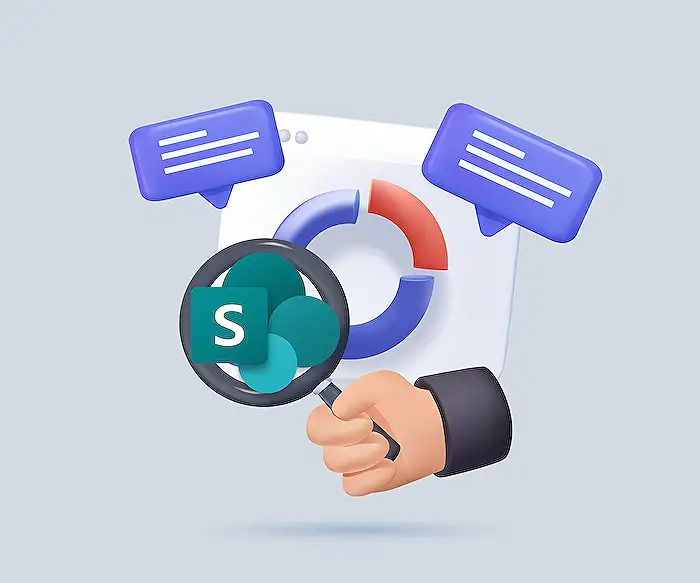
Introduction to Editorial Card web part for SharePoint
Software Development Redmond, Washington
SharePoint Editorial Card web part elevate page aesthetics functionality new features configuration roadmap
Key insights
- Editorial Card Web Part: A new feature in SharePoint designed to enhance the visual appeal and functionality of pages and news posts.
- Design Layouts: Offers three layout options - Image Overlay, Color Block, and Split - to customize content presentation effectively.
- Rich Content Elements: Allows customization with elements like Section/Category Name, Headline, Description, and Call to Action.
- Flexible Customization: Provides advanced image editing, multiple content alignment choices, and various call-to-action types for tailored appearances.
- Adding the Editorial Card Web Part: Enter edit mode on your SharePoint page, add a new web part by searching for "Editorial Card," then customize as needed.
- Availability: The feature is being rolled out in stages with general availability expected by the end of February 2025.
Unveiling the Editorial Card Web Part for SharePoint
Microsoft has recently introduced an innovative feature for SharePoint users, the Editorial Card web part. This addition is set to transform the way users design and customize their SharePoint pages and news posts. In this article, we will delve into the key features of this new tool, explore how to integrate it into your SharePoint environment, and discuss the potential challenges and benefits it brings.
Key Features of the Editorial Card Web Part
The Editorial Card web part is designed to enhance both the aesthetics and functionality of SharePoint pages. It offers a range of features that allow users to create visually appealing and engaging content. Some of the standout features include:
- Design Layouts: Users can choose from three distinct layouts to best suit their content needs. These include:
- Image Overlay: This layout combines visuals and text with an overlay effect, perfect for highlighting important information.
- Color Block: This option uses bold, vibrant sections to make content stand out.
- Split: This layout elegantly divides content, placing images and text side by side for a balanced presentation.
- Rich Content Elements: Each card can be customized with elements such as Section/Category Name, Headline, Description, and Call to Action, allowing for a tailored approach to content presentation.
- Flexible Customization: Users have access to advanced image editing options, multiple content alignment choices, and various call-to-action types, enabling them to tailor the card’s appearance and functionality to their specific needs.
How to Add the Editorial Card Web Part
Integrating the Editorial Card web part into your SharePoint page is a straightforward process. Here are the steps to follow:
- Navigate to your SharePoint page and enter edit mode by selecting Edit at the top right.
- Click the + icon to add a new web part.
- Search for Editorial Card in the web part menu and select it.
- Customize the card by filling in the desired content fields and adjusting the layout and design settings as needed.
For those who require a more detailed walkthrough, Microsoft provides an official guide that can be referred to for additional support.
Benefits and Tradeoffs of Using the Editorial Card Web Part
The Editorial Card web part offers numerous benefits, making it a valuable addition to any SharePoint user's toolkit. However, like any tool, it also comes with its own set of tradeoffs. Let's explore these aspects:
- Enhanced Visual Appeal: The ability to choose from different layouts and customize content elements allows users to create visually appealing pages that capture the audience's attention.
- Improved Engagement: By utilizing rich content elements and flexible customization options, users can present information in a more engaging manner, potentially increasing user interaction and retention.
- Learning Curve: While the tool is designed to be user-friendly, there may be a learning curve for those unfamiliar with SharePoint or web part integration. Users may need to invest time in understanding the full capabilities of the tool.
- Resource Allocation: Customizing and maintaining visually appealing content may require additional resources, such as design expertise or time commitment, which could be a consideration for some organizations.
Challenges and Future Roadmap
As with any new feature, there are challenges associated with the implementation and use of the Editorial Card web part. Microsoft is aware of these challenges and has outlined a future roadmap to address them:
- Staged Rollout: The new web part is being rolled out in stages, with general availability expected by the end of February 2025. This phased approach allows Microsoft to gather user feedback and make necessary adjustments before full deployment.
- User Feedback: Microsoft is actively seeking feedback from early adopters to identify areas for improvement and ensure the tool meets user needs effectively.
- Continuous Improvement: Microsoft is committed to continuously improving the Editorial Card web part, with plans to introduce additional features and enhancements based on user feedback and evolving needs.
Conclusion
The introduction of the Editorial Card web part marks a significant step forward in enhancing the visual appeal and functionality of SharePoint pages. With its versatile features and customization options, it empowers users to create engaging and aesthetically pleasing content. However, as with any new tool, it is important to consider the tradeoffs and challenges involved in its implementation. By understanding these factors and leveraging the tool effectively, users can maximize its potential and elevate their SharePoint experience.
For a visual demonstration and further insights into the Editorial Card web part, the accompanying video from Microsoft provides a comprehensive overview and practical examples of its use.

Keywords
SharePoint Editorial Card web part introduction SEO tips guide tutorial 2025 best practices